Last week we have been able to build the foundation of RESTful API with Express. Our server could handle CRUD eventhough it is not really efficent. Also, it is only alive when our computer is still running, as it operate on our local machine. This week, we will learn how to build a better structured RESTful API that deploy for public access..
What You'll Learn
- Express: We will use this minimal and flexible Node.js web application framework that we have learnt in previous weeks.
- MongoDB: No SQL database.
- MongoDB Compass: Graphic User Interface for MongoDB
- Mongoose: MongoDB object modeling and method for Node.js.
- JWT - JSON Web Token : Access Token Authentication
- Bcrypt: Password security
- Cloudinary: Media upload to cloud
Before diving into the database, let's review our routing logic with Express. In general, a flow of buidling an Express RESTful api will looks like this.
1. Setup project structure
Either it is front-end or back-end, this will be the most important part of the project. By deciding on where to keep files and how to connect them within the code base, you are winning half the battle. Your project folder will look like:
|- controllers/
|- a.controller.js
|- b.controller.js
|- models/
|- A.js
|- B.js
|- public/
|- routes/
|- index.js
|- a.api.js
|- b.api.js
|- .env
|- .gitignore
|- app.js
|- package.json
|- README.md
routes/stores.apifiles that determine routes end point which is a URI and a specific HTTP request method (GET, POST, and so on). Each route have a handler function which is defined in.controllerfile.controller/stores all function that interact with your database.models/stores the schemas that map with the collections in your MongoDB.
2. Design the endpoints
In this step, we are designing REST APIs for our application. The main question is how to apply REST principles in design process?
The very first step is identifying the objects which will be presented as resources, which are:
- auth: for authentication process
- A: CRUD of A
- B: CRUD of B
Next, it's time to decide the resource URIs which are endpoints of our RESTful services. Think about the relationship between resources and its sub-resources (e.g. Product vs Category, User vs Order in an ecommerce , shopping application).
/*
* @route GET api/products?page=1&limit=10 - Get all products
* @route GET api/products/category/:id?page=1&limit=10 - Get all products with specific category
* @route POST api/auth/register - Create a new account
* @route PUT api/users/me - Update user profile
* @route DELETE api/reviews/:id - Remove a review
*/
Notice: URIs should be nouns only, don't use any verb or operation like:
-@route POST api/products/create_blog - Create a new product
Assign HTTP Methods:
A user can perform browse, create, update, or delete operations. Typically we assign:
- GET for browsing
- POST for creating
- PUT for updating
- DELETE for removing
3. Authorization:
If there are different roles of users in your system, you should pre-define who can see/do what. Example: we allow everyone to see the list of products so the endpoint will look like:
/**
* @route GET api/products?page=1&limit=10
* @description Get products with pagination
* @access Public
*/
But if user want to write a review, they need to login, so the endpoint will be defined:
/**
* @route POST api/review
* @description Create a new review for a product
* @access Login required
*/
Web Application Flowchart
This is how every part of web programming connect (Web)
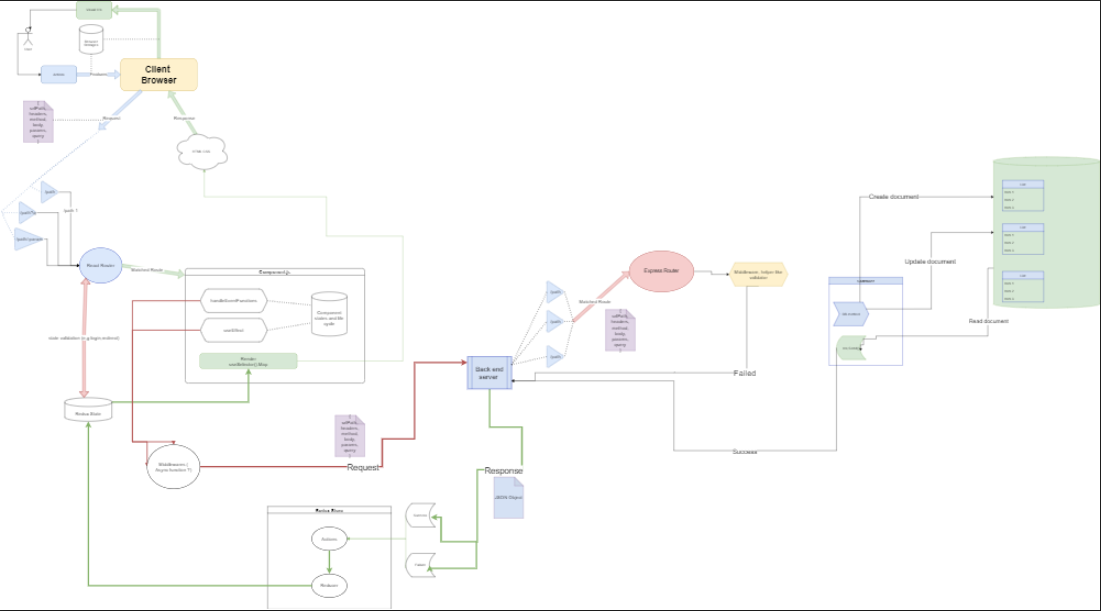
Definition of Database
"In computing, a database is an organized collection of data stored and accessed electronically from a computer system. Where databases are more complex they are often developed using formal design and modeling techniques.
Database management system (DBMS)
The database management system (DBMS) is the software that interacts with end users, applications, and the database itself to capture and analyze the data. The DBMS software additionally encompasses the core facilities provided to administer the database. The sum total of the database, the DBMS and the associated applications can be referred to as a "database system". Often the term "database" is also used to loosely refer to any of the DBMS, the atabase system or an application associated with the database.
Computer scientists may classify database-management systems according to the database models that they support. Relational databases became dominant in the 1980s. These model data as rows and columns in a series of tables, and the vast majority use SQL for writing and querying data. In the 2000s, non-relational databases became popular, referred to as NoSQL because they use different query languages." _wikipedia
Both a database and its DBMS conform to the principles of a particular database model. "Database system" refers collectively to the database model, database management system, and database.
SQL vs NoSQL
We choose NoSQL. The reason : "Beginner friendly yet as effective as the other". Eventually, it is recommended that , as a developer, we should have basic knowledge on both systems. So for those who have FOMO (Fear-Of-Missing-Out), feel free to study both.
Comparision of NoSQL and SQL
System | Pros | Cons |
SQL | Flexible queries, Reduced data storage footprint, Strong and well-understood data integrity semantics | Rigid data models, Limited horizontal, Single point of failure scalability |
NoSQL | Scalable and highly available, Flexible data models, Dynamic schema for unstructured data, High performance, High-level data abstractions | Distributed systems have distributed systems problems, Lack of flexibility in access patterns |
In bigger application, you may find that both system could be in use for the database.

MongoDB is a document database with the scalability and flexibility that you want with the querying and indexing that you need. As a DataBaseManagementSystem software, MongoDB provide various functions that allow management of a database and its data which can be classified into four main functional groups:
- Data definition : Creation, modification and removal of definitions that define the organization of the data.
- Update : Insertion, modification, and deletion of the actual data.
- Retrieval : – Providing information in a form directly usable or for further processing by other applications. The retrieved data may be made available in a form basically the same as it is stored in the database or in a new form obtained by altering or combining existing data from the database.
- Administration: Registering and monitoring users, enforcing data security, monitoring performance, maintaining data integrity, dealing with concurrency control, and recovering information that has been corrupted by some event such as an unexpected system failure
Installing MongoDB for Mac
Although Mongo DB official document try to be helpful, but their instruction for Mac user is out-of-dated. You will stumble upon error from 10.0 Catalina , Big Sur , ... to Monterey, as at November 2021.
TLDR : Quick start commands
Input these line in the following order to
Install
/bin/bash -c "$(curl -fsSL https://raw.githubusercontent.com/Homebrew/install/HEAD/install.sh)"
brew update
brew upgrade
brew tap mongodb/brew
brew install mongodb-community@4.4
echo 'export PATH="/usr/local/opt/mongodb-community@4.4/bin:$PATH"' >> ~/.zshrc
sudo mkdir -p /System/Volumes/Data/data/db
alias -g mongod="sudo mongod --dbpath /System/Volumes/Data/data/db"
source ~/.zshrc
To run
mongod
Explanation
Since the new updates, Apple do not allow service like mongod and brew to access to home folder. MongoDB however, need a /Data/data/db to contain all data. So the step were
- Install Home brew : package manager that help ease the installation for Mac and Linux
- Search for new
updatethenupgradehome brew - Connect to the
mongodb/brewtap on github - Install the community edition of mongod via brew . Current version is (mongo-community@4.4)
- Create a congfig ~/.zshrc (or ~/.bashrc but i would recommend install Oh my zsh to use zsh), then export the Path to mongo executed files to
Machine's rootso that we could use themongo serviceswith CLI everywhere. - Super User access to create
Data/data/dbatSystem/Volumes - Super User to Change Ownership to the foler we just created. Why? Because without the ownership we can not Write to the folder
- To run
mongodbwe must specify which folder to use as thedbfolder . Which is the one we just created.Hencemongod --dbpath /System/Volumes/Data/data/db. - But
mongod --dbpath /System/Volumes/Data/data/dbis long and we kinda have to type it everytime we want to run mongodb. so we use Super User access to create an shorter version , hencealias sudo mongod --dbpath /System/Volumes/Data/data/db - Save and execute sourcing zsh config.
Installing Mongo DB for Windows
Lucky for us, the installation for Windows on this Mongo DB official document still valid as at October 2021
- Select Create an Organization
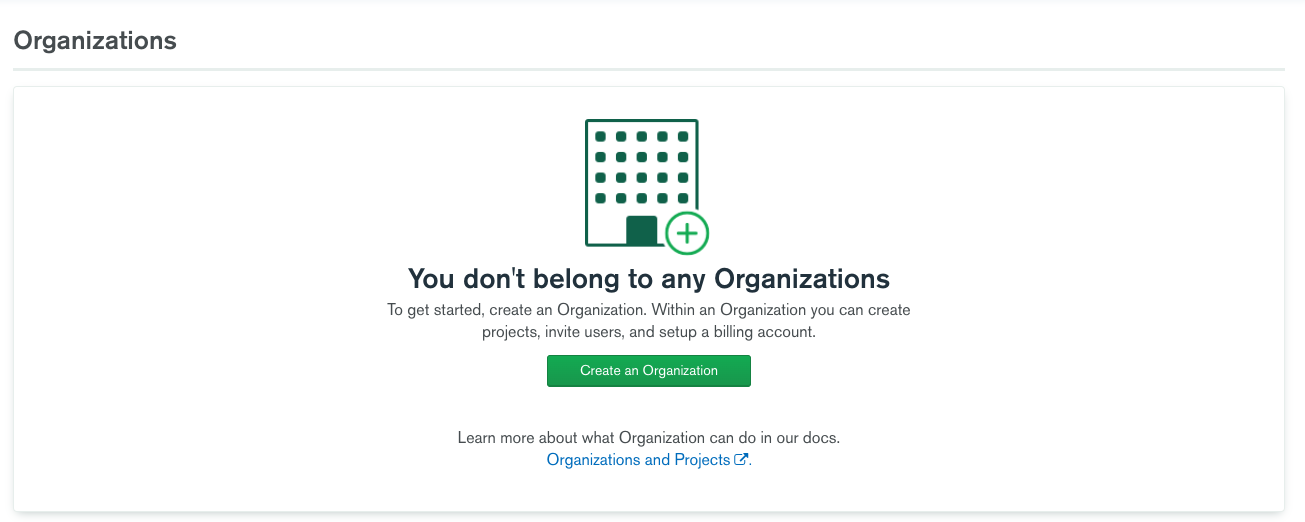
- Name your Organization
MDBU. Make sure that your cloud service is Atlas, then hit Next.

- Hit Create Organization
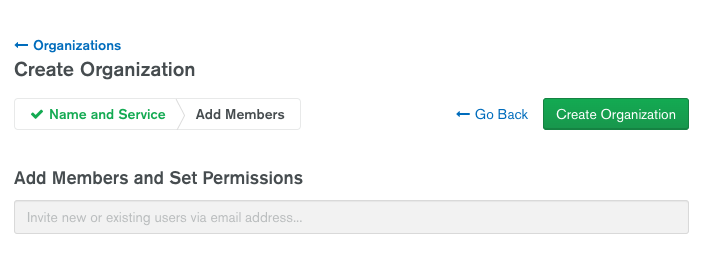
- Hit New Project

- Name your Project
M001and hit Next
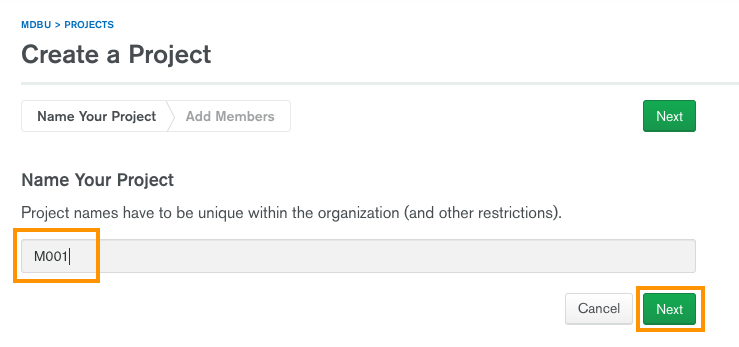
- Select Create Project
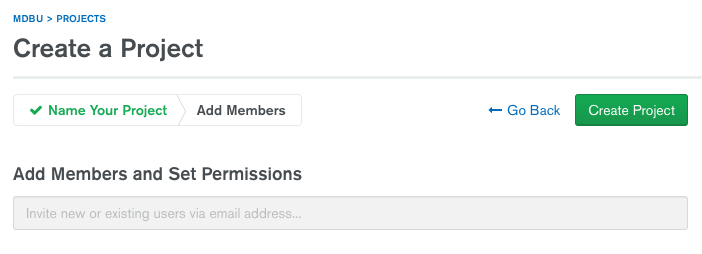
- Select Build a Cluster
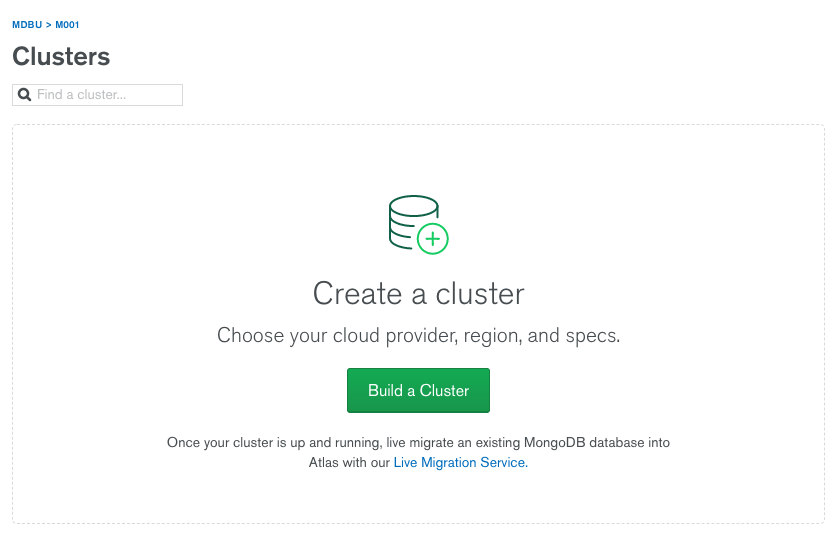
- Select the left-most option that is FREE and hit Create a cluster
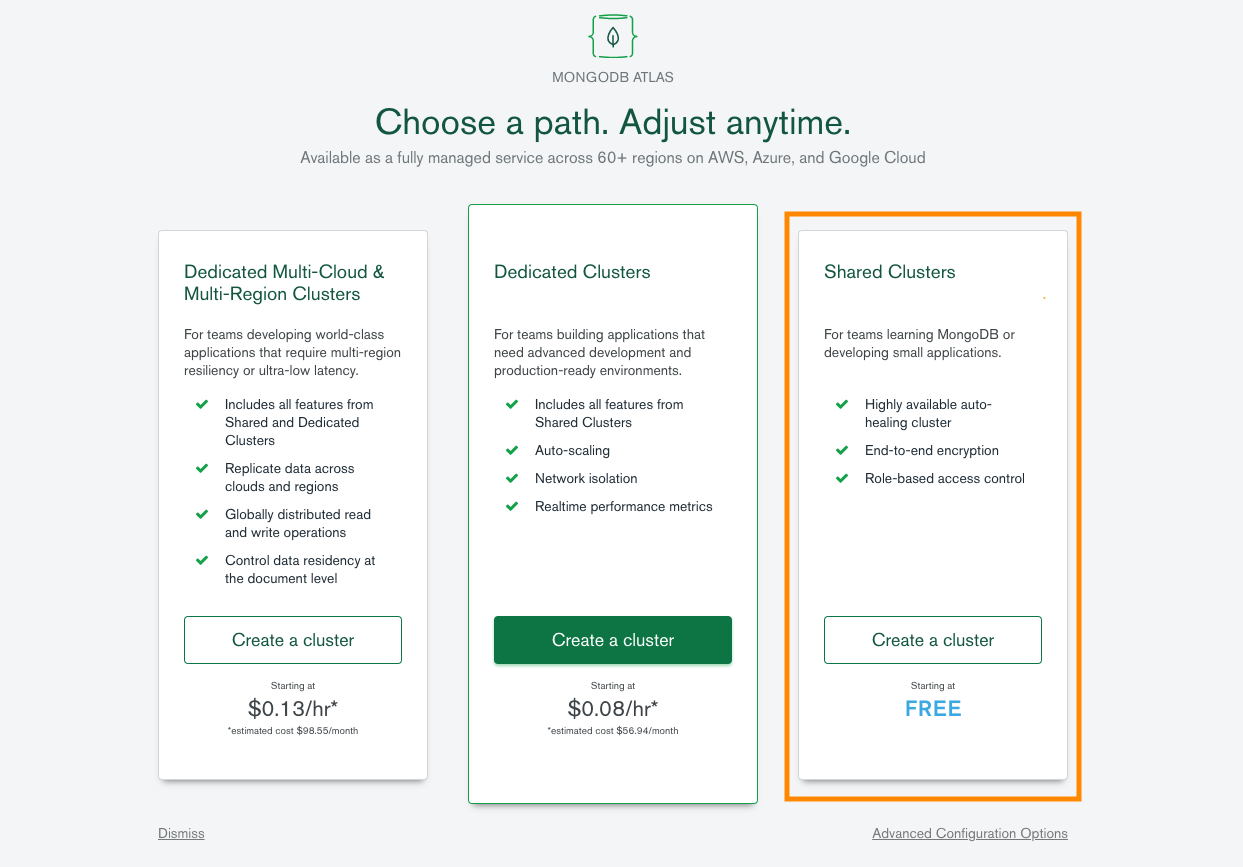
- Select the region that is geographically closest to your location. On the bottom of the page change the cluster name to
Sandbox. Create the cluster. This step might take a minute or two to complete.
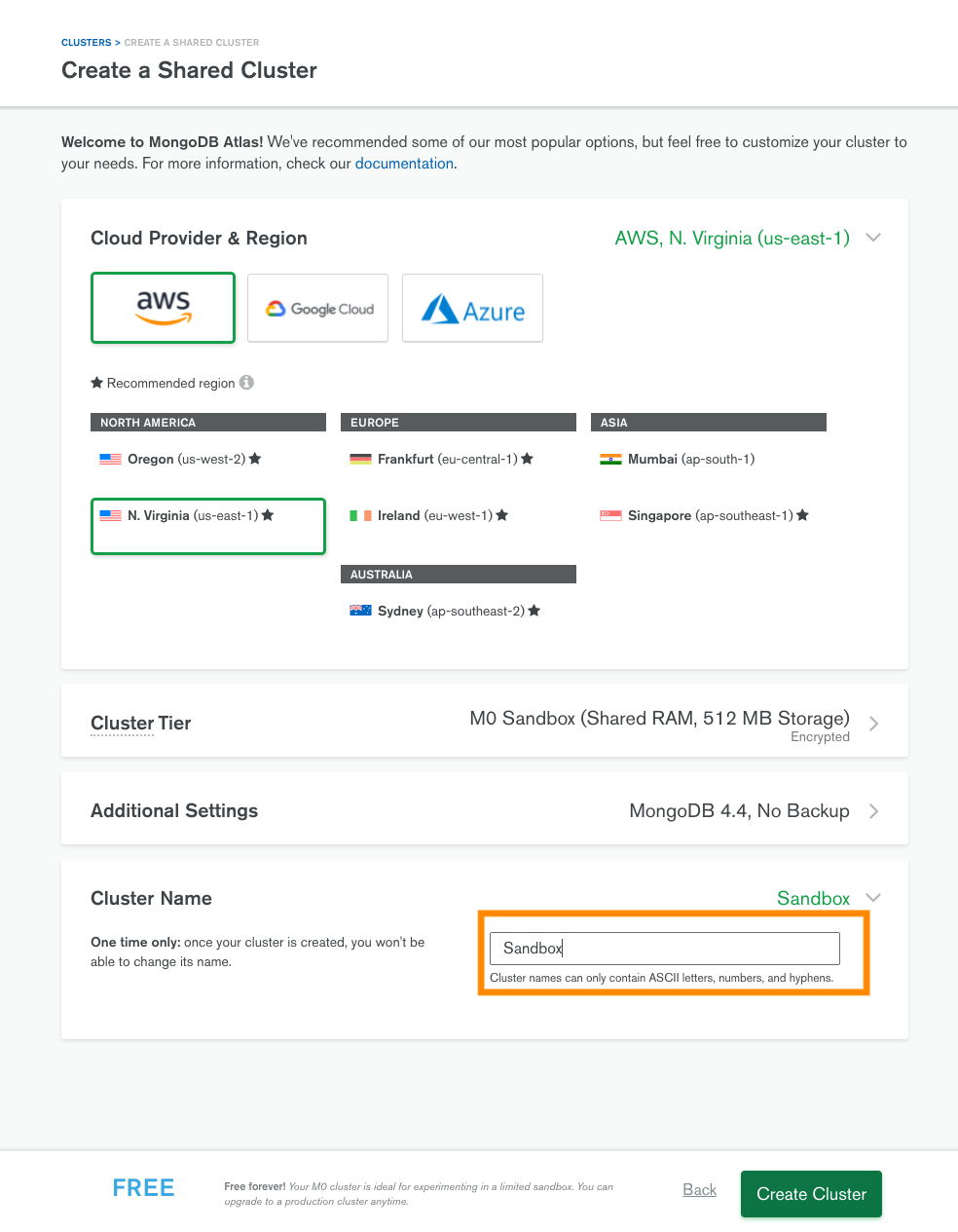
- Now that you have an Atlas cluster you need to grant access to your IP Address and create a Database User.
- Select Connect from the cluster view.
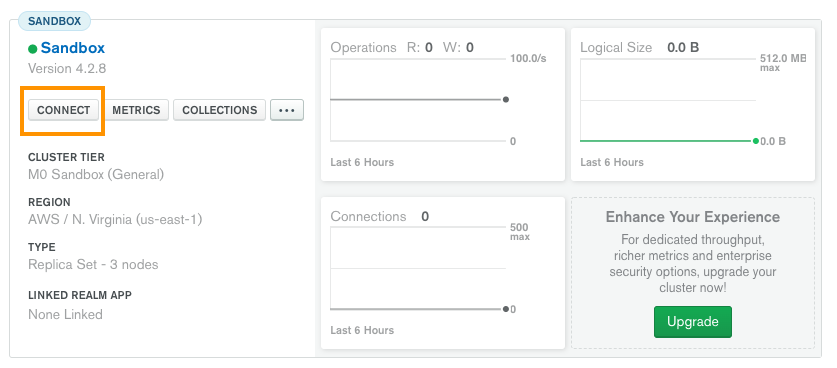
- Select the right-most option Allow Access from Anywhere and confirm your selection by clicking on Add IP Address. Allowing access from anywhere is not* a good security practice. Clusters that are used for production should **not have this enabled.
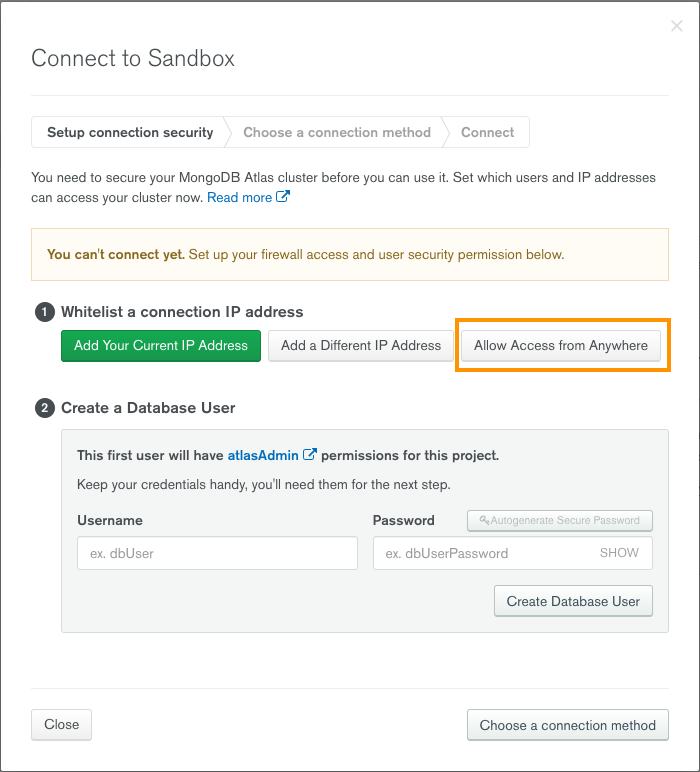
- Create a Database User, then click on Create Database User
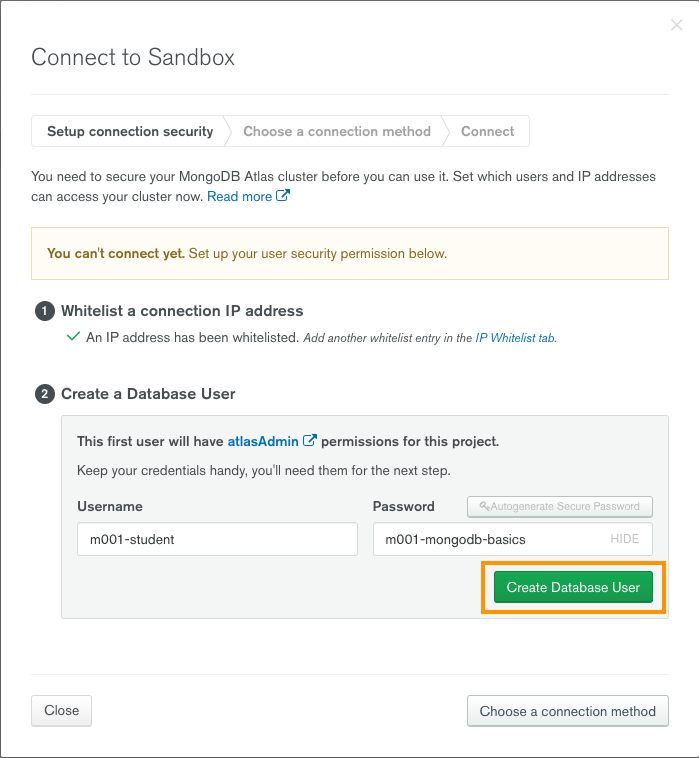
- Close the Connection menu at the lower left corner of the window.
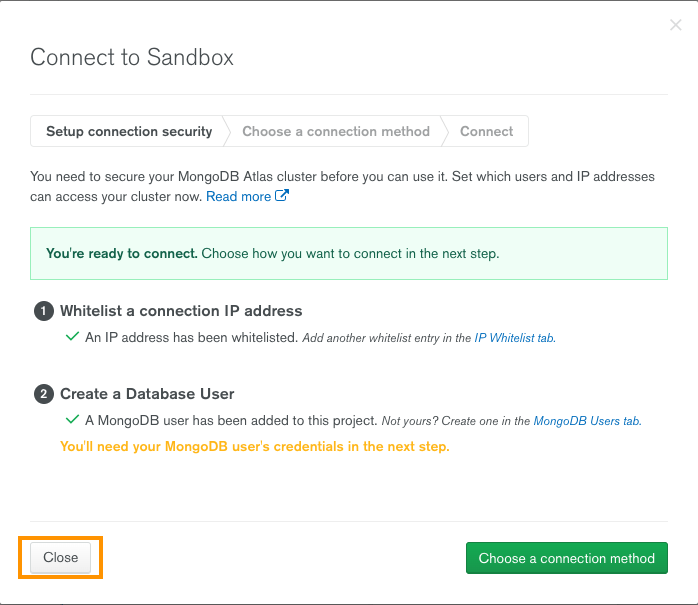
- Select Connect from the cluster view.
Load the Sample Dataset (for practicing)
Select the "..." option in the cluster menu -> choose the "Load Sample Dataset" option, then confirm your choice.

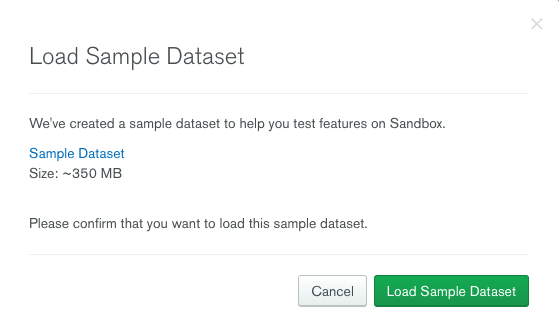
When the dataset is loaded the graph labeled "Logical Size" on the right side of the screen should go up and display the size of the dataset that is above zero and below 512 MB. Your graph may look different than the picture below.
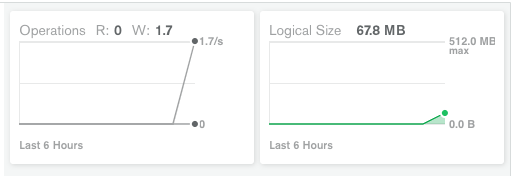 {"mode":"full","isActive":false}
{"mode":"full","isActive":false}
Further resources
- A good to have certificate for better understanding of Mongo Ecosystem M001 Mongo Certificate
- Read more on the debate SQL vs noSQL
- Fear of missing out ? Add SQL to your arsenal
- Download and install MongoDB Community Edition (Windows)
- Download and install MongoDB Community Edition(Mac)
- Grab this free and easy certificate from MongoDB M001 course